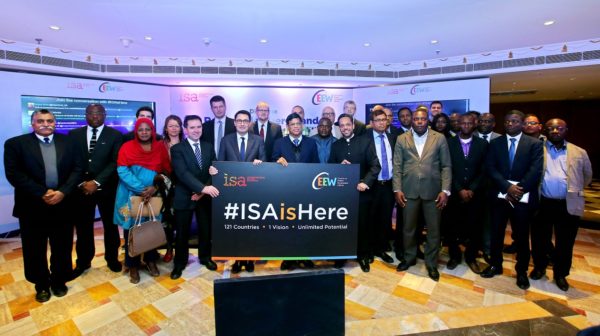In 2017, $333.5 billion was invested in clean energy, 3% higher than 2016. Solar investments reached $160.8 billion, 18% year-on-year growth. But more than half of the solar investment was in China. Longer-term trends suggest the share of foreign capital in asset financing in China, Brazil, or India ranges between 4% and 18%. This is far lower than in ‘rich’ countries: about 40% in Canada and the USA, and as high as 63% in the U.K. Investment is still not flowing to regions where the sun shines the brightest.
Cost of finance
Tariffs for solar and wind have fallen to record lows. A project in Saudi Arabia invited a bid of $0.0178/kWh. Onshore wind fell to $0.0186/kWh in Mexico. In India, solar and wind tariffs reached $0.038 and $0.041 per unit, respectively. But will the prices fall even lower? Not unless several risks are mitigated.
At the Council on Energy, Environment and Water, we and our colleagues have compared bids in India against even lower prices elsewhere. The differential was not as much due to the cost of the components, or operations and maintenance. The real reason was the cost of finance, i.e. return on equity and debt servicing. Whereas it accounted for about 50% for bids in Dubai, for instance, it was 66% in the lowest solar bid India has achieved.
Risks beyond the projects
Some risks are inherent to project development. Once up-front capital costs are incurred, power must be sold, without delay or default, in order to avoid recurring losses. The capacity of the grid to absorb renewable power is critical. Even with plans to install transmission infrastructure, RE capacity is installed more quickly, increasing risk of curtailment.
Further, delays in land acquisition add to construction and commissioning risks, adding to the cost of finance. The difficulty of securing large, contiguous tracts of land has made developers intentionally scale down projects.
Such project-specific risks can be managed. For the Rewa project in Madhya Pradesh, India, a clause of deemed generation was introduced: In case the grid is not available, the developer will still be paid for power generated. And to reduce project delays and risks of commissioning, Rewa also solved the land constraint by offering developers land within the solar park in advance.
But there are other risks, well beyond the control of individual project developers. It is harder to predict curtailment when the financial health of distribution companies is in play. PPAs might oblige them to offtake power, but enforcement of contract varies regionally.
A second major non-project risk is foreign exchange. If a currency’s value fluctuates frequently, the burden of debt denominated in foreign currency could greatly increase with devaluation. Moreover, many developing countries also have the risk of inconvertibility, making foreign investors wary of locking in their money in jurisdictions from which they cannot withdraw easily.
Pool risks to push clean energy
Existing options to hedge against risks are either narrow in scope or too expensive. An alternative is possible: A multi-risk, multi-country approach reduces the exposure for any single player. At least three categories of risk – offtaker, currency, and political – could be handled through a single facility: the Common Risk Mitigation Mechanism (CRMM).
The International Solar Alliance (ISA) was born on December 6, 2017, as the world’s newest intergovernmental treaty-based organization. Its value proposition is simple: By pooling demand across solar resource-rich countries, existing solar technologies get a larger market for deployment, the cost of finance could be reduced, and financial resources pooled for investing in next generation solar and related technologies.
On May 18 2017, the governments of several ISA member states entrusted an international taskforce to structure a common mechanism aimed at de-risking investments in solar. The taskforce consisted of the Council on Energy, Environment and Water (CEEW), the Currency Exchange Fund (TCX), the Terrawatt Initiative, and the Confederation of Indian Industry (CII).
Need for a platform
The proposition is to provide solar resource-rich countries with a “high-speed route” through which they can access finance at lower cost and in larger volumes. As a pilot, this collective route would finance a first tranche of 15 GW in 20 countries over five years, with approximately $10 billion of senior debt to be channelled and de-risked.
The collective ISA-driven high-speed route would consist of:
- A digital platform to pool demand and establish a marketplace connecting financiers, solar project developers, and insurers, and create competition among them.
- A common guarantee to mitigate the risks that cannot be eliminated.
- A common regulatory framework to further reduce transaction costs.
Governments would share information on the platform and request a quote for a guarantee in advance. Quotes would be encoded in a public digital ‘key,’ allowing each project to be traced from the initial tender to the issuance of a guarantee.
The guarantee mechanism would consist of a risk transfer instrument, to provide dedicated swaps and guarantees on a list of main risks. The guarantee entity would minimize capital requirements by transferring a large part of the risk to existing instruments offered by multilateral development banks. Existing de-risking mechanisms could thus benefit from better access to a larger pipeline of solar projects.

Image: CEEW
How would ISA members benefit?
First, risk mitigation. Projects could access guarantee mechanisms at an affordable price, through competition between insurers. This would further mitigate risks relating to delay in payments or currency fluctuation.
Second, foreign investment. CRMM insured projects would have a rating of AA and above. This would attract foreign investment, and further drive down the cost of solar electricity.
Third, consolidated markets. The CRMM would leverage public money, which if used to underwrite risks could lower the cost of private finance and increase capital accessible to developing countries. In short, it would create a large aggregated global market for solar projects.
Fourth, NDC commitments. In 2018 pressure will mount on countries to ratchet up climate commitments. The ripple effect of scaling up solar in ISA member countries, aided by CRMM, could help many developing countries present a strong case against the mounting pressure.
Fifth, climate leadership. With the exit of the U.S. from the Paris Agreement, a seat has opened up at the head table. India with its action and ambition in renewables is well placed to take that seat. Through the CRMM, and as a potential key backer of the initiative, India could share its lessons with other developing countries, and make a larger impact.
How would ISA benefit?
First, signalling action. ISA’s unique value is its focus on being action-oriented. As a market instrument that could mobilize finance for solar deployment, the CRMM could support ISA in signalling its commitment to practical solutions, with the potential to transform markets.
Second, responsive to member states. The CRMM would respond directly to the objectives identified by ISA members. The CRMM responds to the needs of countries struggling to harness their solar resource due to lack of affordable finance. In the process, CRMM also supports the development of harmonized solar markets in participating countries.
Third, collaboration with the private sector. A noteworthy feature of the ISA is its commitment to engage with the private sector to boost solar in member countries. The CRMM would create a marketplace for existing and new private and public insurers to access new and consolidated bundles of solar projects. Further, it would also facilitate the creation of new markets for solar developers in countries with abundant solar potential.
And fourth, expanding membership. Through the CRMM, the ISA could successfully support countries in accessing new and affordable finance for solar projects, and develop an integrated global solar market. As a result, more countries would see the benefits of being associated with the ISA. This could support the ISA’s endeavors in expanding its membership base and achieving its broader vision.
Kanika Chawla is Senior Program Lead and Dr. Arunabha Ghosh is CEO, Council on Energy, Environment and Water. Chawla is one of three primary authors of the CRMM concept. CEEW serves as the secretariat of the CRMM Taskforce.
The views and opinions expressed in this article are the author’s own, and do not necessarily reflect those held by pv magazine.
This content is protected by copyright and may not be reused. If you want to cooperate with us and would like to reuse some of our content, please contact: editors@pv-magazine.com.








You have rightly said that “project-specific risks can be managed”. On its part the Govt agencies should state clear guidelines and rules so that stakeholders are clear of their roles and responsibilities. Recently the MERC (Maharashtra Regulator) laid down clear procedural guidelines with estimated timelines for obtaining captive power plant status – which will help private PPAs by RE developers. https://indiaenergyinsights.wordpress.com/2018/01/22/electricity-regulator-lays-down-process-for-establishing-captive-status/
Is this data from CEEW? – In 2017, $333.5 billion was invested in clean energy, 3% higher than 2016.
Yes, the authors are clearly mentioned.
How much the state agecies are oriented to involve in the NSM. The distribution sector still suffers with poor infrastructure. This weekness.is a deternt to the Rooftop solar projects, especislly in states like Kerala, which generates hardly less than 30% of its requirment.